I'm unable to come up with an algorithm to detect weakly simple polygons (i.e. polygons where the sides are allowed to touch but not cross over). Currently I am just checking for intersections between every side - here is the function I call for all non-adjacent sides. This way, only simple polygons are allowed (no touching at all). Polygons are vectors of points.
bool linesIntersect(const point &a1, const point &a2, const point &b1, const point &b2) {
// Solve intersection of parametric lines using inverse matrix
// The equation of the parametric lines are line1 = (a2 - a1)*s + a1
// and line2 = (b2 - b1)*t + b1, where a1, a2, etc. are vectors.
// Two equations can be produced from the two components, and these
// this system of two equations can be solved for s and t
// If the parameters s and t are between 0 and 1, it means that the lines intersect
float x21 = a2.x - a1.x, x43 = b2.x - b1.x, x31 = b1.x - a1.x,
y21 = a2.y - a1.y, y43 = b2.y - b1.y, y31 = b1.y - a1.y;
float determinant = x43*y21 - x21*y43;
if(determinant == 0.) return false;
float s = float(x43*y31 - x31*y43)/determinant;
float t = float(x21*y31 - x31*y21)/determinant;
if(s <= 1. && s >= 0. && t <= 1. && t >= 0.) return true; // lines intersect
return false;
}
Using s < 1. && s > 0. && t < 1. && t > 0. does not work because it accepts some complex polygons as simple.
The first figure in this question shows a couple of examples. Below is a typical weakly simple polygon that the program would be dealing with.

I would prefer pseudocode since the math jargon in the aforementioned question (1) scares me and I don't think I have the knowledge to implement any complex algorithm. I am using Boost.Polygon for something else if there's something in there, but I didn't find anything.
EDIT:
Here is how I use the function. checkPts is a vector<point> with an assumed side from the last point to the first.
// Check for self-intersecting polygons
for(int i = 0; i < checkPts.size() - 2; ++i) {
for(int j = i + 2; j < checkPts.size() - 2; ++j) {
if(linesIntersect(checkPts[i], checkPts[i+1], checkPts[j], checkPts[j+1])) error("self-intersecting polygon");
}
}